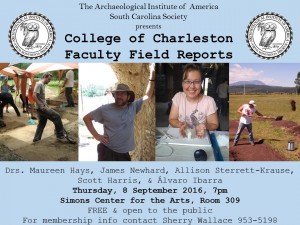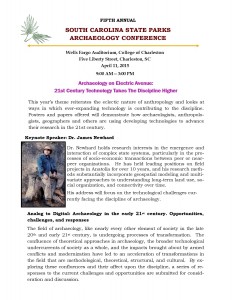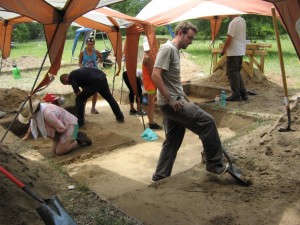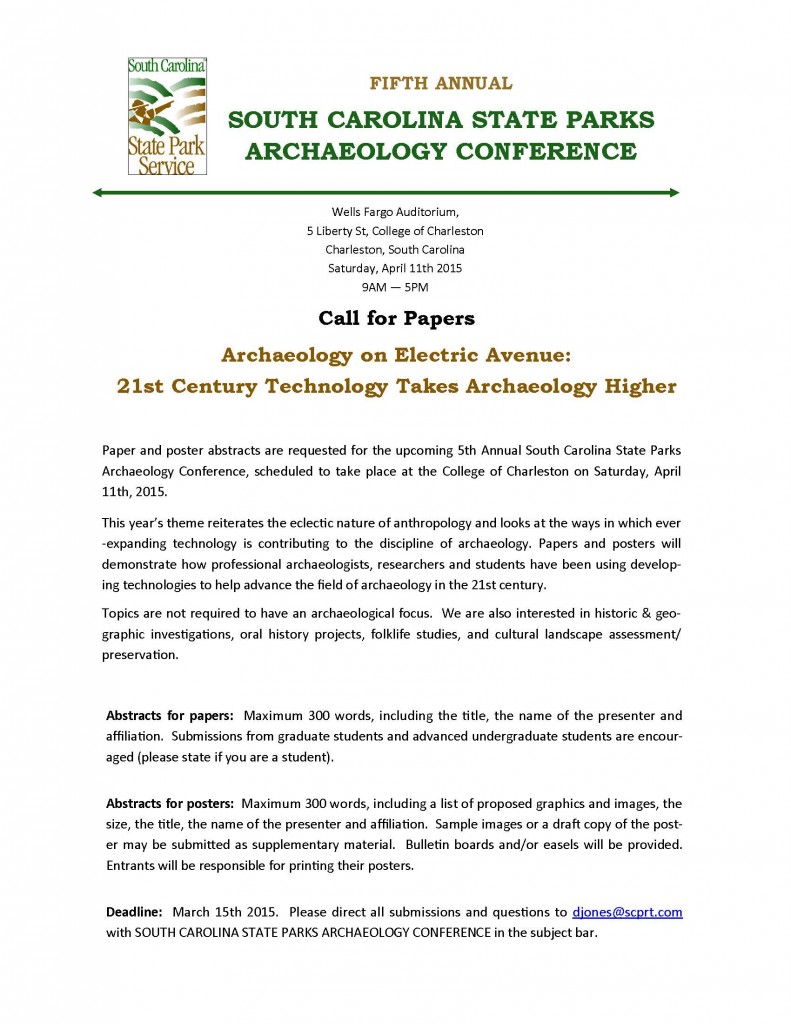Archives For November 30, 1999
After a few weeks at Hampton Plantation, the team turns to possibly exploring the Revolutionary War siege of Charleston.
 For archaeologists at CofC, the summer is time for exploration via fieldwork and in-depth study. In partnership with the South Carolina Society of the Archaeological Institute of America, we present a series of short reports from the field by Drs. Harris, Hays, Ibarra, Newhard, and Sterrett-Krause. Come to hear what new and exciting work is happening!
For archaeologists at CofC, the summer is time for exploration via fieldwork and in-depth study. In partnership with the South Carolina Society of the Archaeological Institute of America, we present a series of short reports from the field by Drs. Harris, Hays, Ibarra, Newhard, and Sterrett-Krause. Come to hear what new and exciting work is happening!
Thursday, September 8 at 7:00pm
Simons Center for the Arts, 309
College of Charleston
On August 25, the Charleston Museum will host a book launch and signing for Martha Zierden (Curator at the Charleston Museum) and Elizabeth Reitz (professor of anthropology, University of Georgia) whose book, Charleston: an Archaeology of Life in a Coastal Community, has been recently published.
In addition to being curator at the Charleston Museum, Zierden holds a courtesy appointment in anthropology at the College of Charleston, and is a long-time collaborator/co-director of the College’s Lowcountry field school.
Book Launch and Signing for ‘Charleston: An Archaeology of Life in a Coastal Community’
For those interested in getting some archaeological experience and being a member of the research team at Dixie Plantation, Dr. Maureen Hays will be offering ANTH493 Field School in Archaeology (4 credits) in Maymester this year (May 16th to May 31st).
This course fulfills the Anthropology major Research Methods requirement and the Capstone requirement for the Archaeology major/minor.
ANTH202 is the prerequisite (or permission of Instructor). If you have taken ANTH202 students will be able to sign up for the course when summer registration opens. If students have not taken ANTH202 but really want to learn something about archaeology, send Dr. Hays an email requesting permission.
The property is owned by the College of Charleston Foundation and located in Hollywood, SC (about 40 minutes from downtown Charleston). Dixie Plantation has a long occupational history (both historic and prehistoric). Focus this summer will be on the early colonial occupation of the site (1700-1750).
The project is co-directed by Dr. Maureen Hays (College of Charleston) and Dr. Kim Pyszka (Auburn University at Montgomery).
For more detail, please see attached.
CofC archaeologists assist with fossil whale recovery in Dorchester County. http://tinyurl.com/ptqv22u
This summer’s field school collected data from several contexts within the Lowcountry. Investigations included soundings at Rose and Hampton Plantations, and historic properties in the urban core of Charleston. See the report from Martha Zierden at the Charleston Museum blog post for more details.
This story is reproduced from its original posting on the Dept. of Sociology and Anthropology blog .
The first two weeks of the archaeology field school were spent working at the site of the Rose Plantation, which is a part of a 600 acre property called the Dill Property on James Island owned by the Charleston Museum. We were working in an area where old maps showed structures that were probably part of this plantation. We found remains of some structures and many artifacts that seem to suggest that we found some of it.
Weeks 3-6 were spent mostly at Hampton Plantation State Historic Site north of Charleston near McClellanville, SC. The field school has worked on this site before but not in this location which was in a large field south of the main plantation house. Our most productive excavation units were located at the southern end of this field, and a considerable distance from the plantation house. These excavations were overseen by David Jones, who coordinates the archaeological program for the State Park Service to include research archaeology and protection of archaeological resources. He was assisted by Stacy Young, who is an archaeologist contracted in the past to excavate part of the old slave residential area at this plantation.
During this period students also rotated through two sites in downtown Charleston to get a feel for urban archaeology, which produces a very different set of challenges. One site was at 86 Church Street, owned by the parents of archaeologist, Martha Middleton. It ended up being a 4 1/2 foot deep single excavation unit with a lot going on in it. The second site was the historic Manigault House, owned by and located across from the Charleston Museum. Excavations were done both in the basement and under the porch.
Historic artifacts were found in all these locations, but lab analysis will be required to determine what it all means. At Hampton Plantation not enough colonoware (pottery commonly made by African slaves, and possibly also Native Americans) was found to suggest that the structure(s) we think we uncovered were those of Africans. There was also no window glass that is usually found in European-style structures. The Seewee Indians were also residents in the area during the colonial period, and our Hampton site may have something to do with them. Lab analysis and, hopefully, more field school research there in two years will be necessary to sort this out.
Students read 21 professional articles on various phases of archaeology, learned to identify about 80 kinds of historic ceramics used for dating purposes, and did additional written work in addition to learning fieldwork skills.
For photos of the 2015 Archaeology Field School, please check out the CofC Sociology and Anthropology Facebook page.
Original posting: http://today.cofc.edu/2015/05/01/discovery-of-rare-key-helps-unlock-dixie-plantations-storied-past/
Some archaeologists dig for years before unearthing a significant artifact.
But College of Charleston student Ben Widder had a bit of beginner’s luck during an archaeology dig last year at the College’s Dixie Plantation, located along the Stono River near Hollywood, S.C.
The senior anthropology major and archaeology minor was participating in his first archaeological field school when he unearthed a key dating to the early 1700s.
“I was using my trowel and I heard the clink of metal hitting metal,” recalls Widder. “I scraped around it pretty quickly when the ring of the key became exposed, and seconds later the tip of the trowel lifted the ring up, exposing the rest of the key.”
“I found a key!” Widder shouted, as his classmates and professor came running.
Maureen Hays, professor of anthropology and associate dean of the School of Humanities and Social Sciences, says the key was probably made before 1707 when a parsonage house for Saint Paul’s Church was constructed on the property. American Indian groups burned the parsonage during the Yamasee War (1715-1717).
“I believe this is a rare find,” says Hays, who is co-director of the archaeological field school along with Kim Pyszka ’92, an assistant professor of anthropology at Auburn University at Montgomery.
Occupied for thousands of years, the site of what is now Dixie Plantation is historically, archaeologically and ecologically significant. The 881-acre property was bequeathed to the College of Charleston Foundation in 1995 by the late conservationist, ornithologist, and artist John Henry Dick.
In recent years, archaeologists digging at Dixie have discovered hundreds of artifacts, including ceramic sherds, tobacco pipe stems and a Spanish coin.
Archeologists have also located the foundation of the old parsonage house. And now, thanks to Widder’s discovery, they have a key associated with the parsonage.
But finding the key was only the first step. The ferrous artifact was heavily oxidized and required months of careful restoration at the hands of archaeologists from the Charleston Museum.
Ron Anthony, one of the museum archaeologists who restored the key using electrolysis, has been teaching at the College as an adjunct professor since 1990.
“It’s a process whereby chlorides locked within the artifact are purged from the artifact via electricity or chemical means,” explains Anthony. “This is a common, safe way to conserve any metal artifact which oxidizes.”
As for Widder, he was just happy to be the one to make the discovery. “If it wasn’t me, it would have been someone else. I just happened to be assigned to that spot.”
 This year’s conference (April 11, 9:00 -3:00; Wells Fargo Auditorium, College of Charleston) will include papers highlighting recent research in the history, archaeology, and societies of the Lowcountry of South Carolina. Many studies reflect the overall theme of the conference, which takes a particular interest into the uses of technology in the study and presentation of the past. Participants include:
This year’s conference (April 11, 9:00 -3:00; Wells Fargo Auditorium, College of Charleston) will include papers highlighting recent research in the history, archaeology, and societies of the Lowcountry of South Carolina. Many studies reflect the overall theme of the conference, which takes a particular interest into the uses of technology in the study and presentation of the past. Participants include:
Olivia Adams: “Examining Cultural Landscapes of the Past: Charles Towne Landing”
Zak Bartholomew: ‘The Use of Geospatial Statistics for Defining Archaeological Sites Using Surface Survey Data”
Caitlin Bennett: “Dental Age Estimation in Subadults: A Re-Evaluation of Standards for Contemporary African American Children”
Carolyn Howle: “Reimagining the New Grange Passage Tomb through Folklore”
Jeremy C. Miller & Aaron Brummitt: “Observing Multi-Site Occupation through Innovative and Affordable Technologies: An Analysis of over 5,000 Years of Human Occupation at 38BK2091, Rebellion Farms”
Hannah Rawcliffe: “Anthropology and Technology: How Can Cultural Heritage Digitization Improve Dissemination of Information to the Public?”
Susan Bergeron: “Reconstructing the Rice Kingdom: Developing an Immersive Virtual Landscape for Historic Hampton Plantation”
Jesse Rouse: “From the Surface Down: Looking for Landscape Change at Hampton Plantation”
Craig Garrison: “Carriage Steps and Charleston’s Streetscape”
Welcoming Remarks by Tracey Burkett, Interim Chair of the Department of Sociology and Anthropology, College of Charleston
Keynote Address by James Newhard, Director of Archaeology, College of Charleston
The conference is sponsored by the SC State Park Service in partnership with the Department of Sociology and Anthropology and the Program in Archaeology at the College of Charleston.








